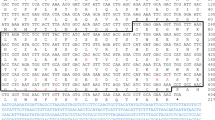Abstract
Lectins play a crucial role in the innate immunity of invertebrates and vertebrates by recognizing and disposing of pathogens. We obtained the complete cDNA of a C-type lectin (EALec1) from Epinephelus akaara using RACE. The complete EALec1 cDNA sequence was 827 bp. The 5-UTR and 3-UTR were 28 bp and 151 bp, respectively, in length. The sequence also contained a polyadenylation signal AATAAA and a poly(A) tail. The EALec1 cDNA encodes polypeptides with 215 amino acids, including a signal peptide of 31 amino acids. The protein has a cysteine-rich region at the N terminal, a collagenous region characterized by G-X-Y repeats, a neck region, and a typical carbohydrate-recognition domain (CRD), indicating that EALec1 is a collectin. The key recognition positions of this CRD are EPD, isolated for the first time in fish. These are likely the interim types, between mannan-binding lectin and galactose-binding lectin. We evaluated the expression pattern of EALec1 in 12 different tissues using RT-PCR. EALec1 was expressed in all tissues, though at different levels. In addition, we inserted EALec1 into an expression vector (pET-28a) for transformation into the BL21 engineering bacteria. Based on enzyme digestion and sequencing of the positive clone, we successfully constructed the EALec1 recombinant expression vector.
Similar content being viewed by others
References
Dah M R, Thiel S, Matsushita M. 2001. MASP-3 and its association with distinct complexes of the mannan-binding lectin complement activation pathway. Immunity, 15: 127–135.
Ellis A E. 2001. Innate host defense mechanisms of fish against viruses and bacteria. Dev. Comp. Immunol., 25(8–9): 827–839.
Ewart K V, Johnson S C, Ross N W. 2001. Lectins of the innate immune system and their relevance to fish health. ICES Journal of Marine Science, 58: 380–385.
Hans-Jurgen H, Kenneth B M. 1994. Collectins — soluble proteins containing collagenous regions and lectin domains -and their roles in innate immunity. Protein Science, 3: 1 143–1 158.
Jackson A N, C A, McLure R L Dawkins, Keating P J. 2007. Mannose binding lectin (MBL) copy number polymerphism in Zebrafish (D. rerio) and identification of haplotypes resistant to L. anguillarum. Immunogenetics, 59(11): 861–872.
Kondo H, Yeu T A, Hirono I. 2007. Identification of a novel C-type lectin gene in Japanese flounder. Paralichthys olivaceus. Fish Shellfish Immunol., 23(5): 1 089–1 094.
Medzhitov R, Janeway J C A. 1998. Innate immune recognition and control of adaptive immune responses. Seminars in Immunology, 10: 351–353.
Nakao M, Kajiya T, Sato Y, Somamoto T. 2006. Lectin pathway of bony fish complement: identification of two homologs of the mannose-binding lectin associated with MASP2 in the common carp (Cyprinus carpio). Immunol., 177(8): 5 471–5 479.
Nikolakopoulou K, Zarkadis I K. 2006. Molecular cloning and characterization of two homologues of Mannose-Binding Lectin in rainbow trout. Fish Shellfish Immunol., 21(3): 305–314.
Panagos P G, Dobrinski K P, Chen X. 2006. Immune-related, lectin-like receptors are differentially expressed in the myeloid and lymphoid lineages of zebrafish. Immunogenetics, 58(1): 31–40.
Russell S, Lumsden J S. 2005. Function and heterogeneity of fish lectins. Vet. Immunol. Immunopathol., 108(1–2): 111–120.
Russell S, Young K M, Smith M. 2008. Cloning, binding properties, and tissue localization of rainbow trout (Oncorhynchus mykiss) ladderlectin. Fish Shellfish Immunol., 24(6): 669–683.
Sharon E, Sharon N, NirB T. 2003. Evolutionary analysis reveals collective properties and specificity in the C-Type lectin and lectin-like domain superfamily. PROTEINS: Structure, Function, and Bioinformatics, 53: 44–55.
Sharon N, Lis H. 1989. Lectins as cell recognition molecules. Science, 246: 227–234.
Tsutsui S, Tasumi S, Suetake H. 2006. Carbohydrate-binding site of a novel mannose-specific lectin from fugu (Takifugu rubripes) skin mucus. Comp. Biochem. Physiol. B. Biochem. Mol. Biol., 143(4): 514–519.
Tsutsui S, Tasumi S, Suetake H. 2005. Demonstration of the mucosal lectins in the epithelial cells of internal and external body surface tissues in pufferfish (Fugu rubripes). Dev. Comp. Immunol., 29(3): 243–253.
Vitved L, Holmskov U, Koch C. 2000. The homologue of mannose-binding lectin in the carp family Cyprinidae is expressed at high level in spleen, and the deduced primary structure predicts affinity for galactose. Immunogenetics, 51(11): 955–964.
Wang H, Song L, Li C, Zhao J. 2007. Cloning and characterization of a novel C-type lectin from Zhikong scallop Chlamys farreri. Mol. Immunol., 44(5): 722–731.
Wang N, Whang I, Lee J. 2008. A novel C-type lectin from abalone, Haliotis discus discus, agglutinates Vibrio alginolyticus. Developmental and Comparative Immunology, 32: 1 034–1 040.
Yuichi E, Momoe T, Teizo F. 2006. Lectin complement system and pattern recognition. Immunobiology, 211: 283–293.
Zelensky A N, Gready J E. 2005. The C-type lectin-like domain superfamily. FEBS J., 272(24): 6 179–6 217.
Zelensky A N, Gready J E. 2004. C-type lectin-like domains in Fugu rubripes. BMC Genomics, 5(1): 51.
Author information
Authors and Affiliations
Corresponding author
Additional information
Supported by the Natural Science Foundation of Fujian Province of China (No. 2060203) and New Century Excellent Talents supporting funding of Fujian Province
Rights and permissions
About this article
Cite this article
Zhang, Z., Ding, S., Wang, Y. et al. cDNA cloning and expression of a collectin from red-spotted grouper (Epinephelus akaara). Chin. J. Ocean. Limnol. 27, 543–549 (2009). https://doi.org/10.1007/s00343-009-9291-z
Received:
Accepted:
Published:
Issue Date:
DOI: https://doi.org/10.1007/s00343-009-9291-z



